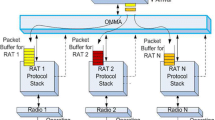Abstract
Ultra wide-band (UWB) technologies are being feverishly developed in the technical community. UWB devices are expected to operate at rates of up to 0.5 Gb/s and communicate with other devices at a range of up to 10 m. Thus, UWB technologies are being developed as core technology for high-speed wireless personal area networks. The salient features of UWB networks—high-rate communications, low interference with other radio systems, and low power consumption—bring many benefits to users. Thus, they enable consumers to experience new applications such as wireless universal serial bus for connecting personal computers to their peripherals and the consumer–electronics in people’s living rooms. However, if multiple WiMedia logical link protocol Service Sets (WSSs) coexist in an adjacent area, various conflicts among independent WSSs can occur frequently. In order to solve this problem, we propose a multi-channel scheduling scheme (MCS) for the coexistence of adjacent WSSs. The proposed MCS scheme can scan new idle channel and detect its time offset where a WSS device can transmit a new beacon frame and data frames without conflicts. We also evaluate the performance of the proposed MCS scheme through various simulations in terms of several metrics. Simulation results demonstrate that the MCS scheme can minimize the possibility of data frame collisions by efficiently managing the multiple available channels in a hybrid manner combining proactive and reactive methods.
















Similar content being viewed by others
Abbreviations
- AC:
-
Access category
- D-MAC:
-
Distributed medium access control
- DRP:
-
Distributed reservation protocol
- IE:
-
Information element
- MAS:
-
Medium access slot
- PCA:
-
Prioritized contention access
- SOP:
-
Simultaneously operating piconets
- UUID:
-
Universally unique identifier
- UWB:
-
Ultra wide-band
- WLP:
-
WiMedia logical link protocol
- WPAN:
-
Wireless personal area network
- WSS:
-
WLP service sets
- WUSB:
-
Wireless USB
References
WiMedia MAC Release Spec. 1.01. (2006). Distributed medium access control (MAC) for wireless networks. http://www.wimedia.org/en/index/asp. Accessed 15 Dec 2006.
WiMedia Alliance. (2007). WiMedia logical link control protocol. Draft 1.0, Aug 2007.
IEEE Std 802.1D\(^{\rm TM}\). (2004). IEEE Standard for local and metropolitan area networks: Media access control bridges. New York: Institute of Electrical and Electronics Engineers Inc.
Shuaib, K., Boulmalf, M., Sallabi, F., & Lakas, A. (2006). Co-existence of Zigbee and WLAN: A performance study. In Wireless telecommunications symposium, 2006. WTS ’06 (pp. 1–6).
Toscano, E., & Lo Bello, L. (2008). Cross-channel interference in IEEE 802.15.4 networks. In IEEE international workshop on factory communication systems, WFCS 2008 (pp. 139–148). 21–23 May 2008.
Shin, S. Y., Park, H. S., & Kwon, W. H. (2007). Mutual interference analysis of IEEE 802.15.4 and IEEE 802.11b. Computer Networks, 51(12), 3338–3353.
Bertocco, M., Gamba, G., & Sona, A. (2008). Assessment of out-of-channel interference effects on ieee 802.15.4 wireless sensor networks. In IEEE Instrumentation and measurement technology conference proceedings, 2008, IMTC 2008 (pp. 1712–1717). 12–15 May 2008.
Yuan, W., Wang, X., & Linnartz, J.-P. M. G. (2007). A coexistence model of IEEE 802.15.4 and IEEE 802.11b/g. In IEEE symposium on communications and vehicular technology, 2007 (pp. 1–5). 15 Nov 2007.
Howit, I., & Gutierrez, J.-A. (2003). IEEE 802.15.4 low rate-wireless personal area network coexistence. Issues Wireless Communications and Networking, 3, 1481–1486.
Koubaa, A., Cunha, & Alves, M., (2007). A time division beacon scheduling mechanism for IEEE 802.15.4/Zigbee cluster-tree wireless sensor networks. In 19th Euromicro conference on real-time systems, ECRTS’ 07 (pp. 125–135).
Feng, G., Liew, S.-C., & Fan, P. (2008). Minimizing interferences in wireless ad hoc networks through topology control. In IEEE International conference on communications (ICC) (pp. 2332–2336).
Won, C., Youn, J.-H., Ali, H., Sharif, H., & Deogun, J. (2005). Adaptive radio channel allocation for supporting coexistence of 802.15.4 and 802.11b. IEEE 62nd Vehicular Technology Conference, VTC-2005-Fall, 4, 2522–2526.
Zhou, T., He, G., Stankovic, J.A., Abdelzaher, T. (2005). RID: Radio interference detection in wireless sensor networks. In Proceedings IEEE INFOCOM 2005. 24th annual joint conference of the IEEE computer and communications societies (Vol. 2, pp. 891–901). 13–17 March 2005.
Kim, T.-H., Ha, J.-Y., Choi, S., & Kwon, W.-H. (2006). Virtual channel management for densely deployed IEEE 802.15.4 LR-WPANs. In Fourth IEEE international conference on pervasive computing and communications (PerCom’06) (pp. 103–115).
T.G. 15.4b. http://grouper.ieee.org/groups/802/15/pub/TG4b.html.
Golmie, N. (2004). Bluetooth dynamic scheduling and interference mitigation. ACM Mobile Networks and Applications, 9(1), 21–31
Leach, P., Mealling, M., & Salz, R. (Jul. 2005). RFC 4122, A universally unique identifier (UUID) URN Namespace. In IETF.
Kim, K.-I. (2012). Adjusting transmission power for real-time communications in wireless sensor networks. Journal of Information and Communication Convergence Engineering, 10(1), 21–26.
Acknowledgments
This research was supported in part by Basic Science Research Program through the National Research Foundation of Korea (NRF) funded by the Ministry of Education (NRF- 2009-0093828) and in part by the MSIP (Ministry of Science, ICT and Future Planning), Korea, under the C-ITRC (Convergence Information Technology Research Center) support program (NIPA-2014-H0401-14-1009) supervised by the NIPA(National IT Industry Promotion Agency).
Author information
Authors and Affiliations
Corresponding author
Rights and permissions
About this article
Cite this article
Kim, JW., Hur, K. & Lee, SR. A Multi-channel Scheduling Scheme for Collision-Free High-Rate WPANs. Wireless Pers Commun 78, 429–448 (2014). https://doi.org/10.1007/s11277-014-1760-9
Published:
Issue Date:
DOI: https://doi.org/10.1007/s11277-014-1760-9




